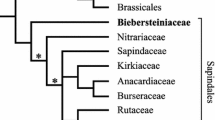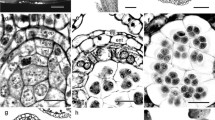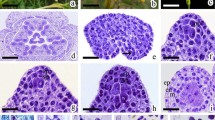Abstract
Embryological data of systematic significance to the family Araceae are reviewed and analyzed, with special attention given to the determination of character-state polarities. Character-states considered primitive within the family include: presence of endothecial thickenings; binucleate, starchless pollen; anatropous, crassinucellate ovules with a thick nucellar cap and a single, unbranched funicular bundle; solanad or caryophyllad embryogeny; helobial endosperm development, with 2–8 cells in the chalazal chamber andab initio cellular division in the micropylar chamber; and endosperm present in ripe seeds. The phylogenetic implications of these conclusions are discussed, and promising avenues for future research are indicated.
Resumen
Se revisan y se analizan los datos embriológicos de importancia para la familia Araceae, haciendo énfasis en la polarización de las facetas de los caracteres. Las facetas consideradas como primitivas dentro de la familia incluyen: existencia de engrosamientos endotécicos; polen binucleado y sin almidón; óvulos anátropos y crasinucelados con caliptra nucelar gruesa y un solo hacecillo funicular no ramificado; embriogénesis de tipo solanáceo o cariofiláceo; desarrollo helobial del endosperma, con 2–8 células en la cámara calazal y división celularab initio en la cámara micropilar; y endosperma presente en las semillas maduras. Se discute el significado filogenético de estas conclusiones, y se indican las lineas de investigación más prometedoras para el futuro.
Similar content being viewed by others
Literature Cited
Banerji, I.. 1937. Sterility inColocasia antiquorum. J. Indian Bot. Soc.16: 159–164.
—. 1947. Life history ofTyphonium trilobatum. Proc. Natl. Inst. Sci. India, Pt. B, Biol. Sci.13: 207–230.
Barabé, D., S. Forget &L. Chrétien. 1987. Organogénèse de la fleur deSymplocarpus foetidus (Araceae). Canad. J. Bot.65: 446–455.
Bawa, K. S. 1980. Evolution of dioecy in flowering plants. Annual Rev. Ecol. Syst.11:15–39.
— &J. H. Beach. 1981. Evolution of sexual systems in flowering plants. Ann. Missouri Bot. Gard.68: 254–274.
Boesewinkel, F. D. &F. Bouman. 1984. The seed: Structure. Pages 567–610in B. M. Johri (ed.), Embryology of angiosperms. Springer-Verlag, Berlin.
Bogner, J. 1978. A critical list of the aroid genera. Aroideana1: 63–73.
—. 1985. One name and five new combinations in Araceae. Aroideana8: 73–79.
—,S. J. Mayo &M. Sivadasan. 1985. New species and changing concepts inAmorphophallus. Aroideana8: 14–25.
Boodle, L. A. &A. W. Hill. 1929.Typhonodorum lindleyanum: The development of the embryo and germination of the seed. Ann. Bot. (London)43: 437–450.
Buell, M. F. 1935. Seed and seedling ofAcorus calamus. Bot. Gaz. (Crawfordsville)96: 758–765.
—. 1938. Embryogeny ofAcorus calamus. Bot. Gaz. (Crawfordsville)99: 556–568.
Campbell, D. H. 1899. Notes on the structure of the embryo-sac inSparganium andLysichiton. Bot. Gaz. (Crawfordsville)27: 153–166.
—. 1900. Studies on the Araceae. Ann. Bot. (London)14: 1–25.
—. 1903. Studies on the Araceae. The embryo-sac and embryo ofAglaonema andSpathicarpa. Ann. Bot. (London)17: 665–687.
—. 1905. Studies on the Araceae, III. Ann. Bot. (London)19: 329–349.
—. 1912. The embryo-sac ofAglaonema. Scott. Bot. Rev.1: 100–115.
Carniel, K. 1963. Das Antherentapetum. Oesterr. Bot. Z.110: 145–176.
Clausen, P. 1927. Ueber das Verhalten des Antheren-Tapetums bei einigen Monocotylen und Ranales. Bot. Arch.18: 1–27.
Cocucci, A. E. 1966. Embriología deSynandrospadix vermitoxicus. Kurtziana3: 157–181.
Cronquist, A. 1981. An integrated system of classification of flowering plants. Columbia University Press, New York.
Dahlgren, R. M. T. &H. T. Clifford. 1982. The monocotyledons: A comparative study. Academic Press, London.
Davis, G. L. 1966. Systematic embryology of the angiosperms. John Wiley & Sons, New York.
Deyl, M. 1955. The evolution of the plants and the taxonomy of the monocotyledons. Sborn. Nár. Mus. v. Praze, Řada B, Přír. Vědy 11(6), Botanica 3: 1–143.
Dudley, M. H. 1937. Morphological and cytological studies ofCalla palustris. Bot. Gaz. (Crawfordsville)98: 556–571.
Duggar, B. M. 1900. Studies in the development of the pollen grain inSymplocarpus foetidus andPeltandra undulata. Bot. Gaz. (Crawfordsville)29: 81–98.
Engler, A. 1879. Araceae.In A. & C. de Candolle (eds.), Monographiae phanerogamarum. Vol. 2. G. Masson, Paris.
—. 1884. Beiträge zur Kenntnis der Araceae V. 12. Über den Entwicklungsgang in der Familie der Araceen und über die Blütenmorphologie derselben. Bot. Jahrb. Syst.5: 141–188, 287–336.
-. 1905. Pothoideae. Pages 1–330in A. Engler (ed.), Das Pflanzenreich21: (IV.23).
-. 1911. Lasioideae. Pages 1–130in A. Engler (ed.), Das Pflanzenreich48: (IV.23).
-. 1912. Homalomeninae und Schismatoglottidinae. Pages 1–134in A. Engler (ed.), Das Pflanzenreich55: (IV.23).
-. 1915. Anubiadeae, Aglaonemateae, Dieffenbachieae, Zantedeschieae, Typhonodoreae, Peltandreae. Pages 1–78in A. Engler (ed.), Das Pflanzenreich64: (IV.23.Bc).
-. 1920a. Aroideae und Pistioideae. Pages 1–274in A. Engler (ed.), Das Pflanzenreich 73: (IV.23.F).
-. 1920b. Araceae pars generalis et index familiae generalis. Pages 1–71in A. Engler (ed.), Das Pflanzenreich74: (IV.23.A).
-& K. Krause. 1908. Monsteroideae. Pages 4–138in A. Engler (ed.), Das Pflanzenreich 37: (IV.23).
- & -. 1920. Colocasioideae. Pages 3–132in A. Engler (ed.), Das Pflanzenreich71: (IV.23.E).
Erbrich, P. 1965. Über Endopolyploidie und Kernstrukturen in Endospermhaustorien. Oesterr. Bot. Z.112: 197–262.
Eyde, R. H., D. H. Nicolson &P. Sherwin. 1967. A survey of floral anatomy in Araceae. Amer. J. Bot.54: 478–497.
Favre-Duchartre, M. 1984. Homologies and phylogeny. Pages 697–734in B. M. Johri (ed.), Embryology of angiosperms. Springer-Verlag, Berlin.
French, J. C. 1985a. Patterns of endothecial wall thickenings in Araceae: Subfamilies Pothoideae and Monsteroideae. Amer. J. Bot.72: 472–486.
—. 1985b. Patterns of endothecial wall thickenings in Araceae: Subfamilies Calloideae, Lasioideae and Philodendroideae. Bot. Gaz. (Crawfordsville)146: 521–533.
—. 1986a. Patterns of endothecial wall thickenings in Araceae: Subfamilies Colocasioideae, Aroideae, and Pistioideae. Bot. Gaz. (Crawfordsville)147: 166–179.
—. 1986b. Ovular vasculature in Araceae. Bot. Gaz. (Crawfordsville)147: 478–495.
—. 1987. Structure of ovular and placental trichomes of Araceae. Bot. Gaz. (Crawfordsville)148: 198–208.
Goebel, K. 1897. Morphologische und biologische Bemerkungen, 5.Cryptocoryne, eine “lebendig gebärende” Aroidee. Flora83: 426–435.
Goldberg, B. 1941. Life history ofPeltandra virginica. Bot. Gaz. (Crawfordsville)102: 641–662.
Gottsberger, G. 1977. Some aspects of beetle pollination in the evolution of flowering plants. Plant Syst. Evol., Suppl.1: 211–226.
Govinde Gowda, M. T. 1980. Endosperm inAriopsis peltata Nimmo, Araceae. Curr. Sci.49: 601–603.
Gow, J. E. 1907. Morphology ofSpathyema foetida. Bot. Gaz. (Crawfordsville)43: 131–136.
—. 1908a. Embryogeny ofArisaema triphyllum. Bot. Gaz. (Crawfordsville)45: 38–44.
—. 1908b. Studies in Araceae. Bot. Gaz. (Crawfordsville)46: 35–42.
—. 1913a. Observations on the morphology of the aroids. Bot. Gaz. (Crawfordsville)56: 127–142.
—. 1913b. Phylogeny of the Araceae. Proc. Iowa Acad. Sci.20: 161–168.
Grayum, M. H. 1984. Palynology and phylogeny of the Araceae. Unpubl. Ph.D. Dissertation. University of Massachusetts, Amherst.
—. 1985. Evolutionary and ecological significance of starch storage in pollen of the Araceae. Amer. J. Bot.72: 1565–1577.
—. 1986a. Phylogenetic implications of pollen nuclear number in the Araceae. Plant Syst. Evol.151: 145–161.
—. 1986b. Correlations between pollen morphology and pollination biology in the Araceae, with some implications for angiosperm evolution. Pages 313–327in S. Blackmore & I. K. Ferguson (eds.), Pollen and spores: Form and function. Academic Press, London.
—. 1987. A summary of evidence and arguments supporting the removal ofAcorus from the Araceae. Taxon36: 723–729.
—. 1990. Evolution and phylogeny of the Araceae. Ann. Missouri Bot. Gard.77: 628–697.
-. (In press). Comparative external pollen ultrastructure of the Araceae, and some putatively related taxa. Monogr. Syst. Bot. Missouri Bot. Gard.
Gregor, H. J. &J. Bogner. 1984. Fossile Araceen Mitteleuropas und ihre rezenten Vergleichsformen. Documenta Naturae19: 1–12.
Guignard, J. L. 1963. Embryogénie des Aracées. Développement de l’embryon chez lePistia stratiotes L. Compt. Rend. Hebd. Séances Acad. Sci.257: 1139–1142.
Guttenberg, H. von. 1960. Embryologische Studien an Monokotyledonen III. Die Embryogenese vonTriglochin maritimum L.,Arum maculatum L. undTypha latifolia L. Flora149: 243–281.
Haines, R. W. &K. A. Lye. 1975. Seedlings of Nymphaeaceae. J. Linn. Soc, Bot.70: 255–265.
Hamann, U. 1977. Über Konvergenzen bei embryologischen Merkmalen der Angiospermen. Ber. Deutsch. Bot. Ges.90: 369–384.
Hanlon, J.-J. 1947. Cell division in the tapetum and the pollen mother cells ofSymplocarpus foetidus. Unpubl. M.S. Thesis. Fordham University.
Hara, H. 1971. A revision of the Eastern Himalayan species of the genusArisaema (Araceae). Pages 321–354in H. Hara (ed.), The flora of Eastern Himalaya, second report. University of Tokyo Press, Tokyo.
Harling, G. 1958. Monograph of theCyclanthaceae. Acta Horti Berg.18: 1–428.
Hay, A. 1988a.Cyrtosperma (Araceae) and its Old World allies. Blumea33: 427–469.
—. 1988b.Anaphyllopsis: A new neotropical genus of Araceae—Lasieae. Aroideana11: 25–31.
Hegelmaier, F. 1874. Zur Entwicklungsgeschichte monokotyledoner Keime nebst Bemerkungen über die Bildung der Samendeckel. Bot. Zeitung (Berlin)32: 631–640, 648–671, 686, 689–700, 705–719.
Henderson, A. 1986. A review of pollination studies in the Palmae. Bot. Rev. (Lancaster)52: 221–259.
Herr, J. M., Jr. 1984. Embryology and taxonomy. Pages 647–696in B. M. Johri (ed.), Embryology of angiosperms. Springer-Verlag, Berlin.
Herrera, J. 1988. Reproducción sexual y multiplicación vegetativa enArisarum simorrhinum Durieu (Araceae). Lagascalia15: 25–41.
Hofmeister, W. 1858. Neuere Beobachtungen über Embryobildung der Phanerogamen. Jahrb. Wiss. Bot.1: 82–188.
—. 1861. Neue Beiträge zur Kenntnis der Embryobildung der Phanerogamen. II. Monokotyledonen. Abh. Math.-Phys. Cl. Königl. Sächs. Ges. Wiss.7: 631–760.
Hotta, M. 1971. Study of family Araceae. General remarks. Jap. J. Bot.20: 269–310.
—. 1976. Notes on Bornean plants. III.Pedicellarum andHeteroaridarum, two new genera of the aroids. Acta Phytotax. Geobot.32: 142–146.
Howarth, J. 1957. The phylogeny of monocotyledons. Unpubl. Ph.D. Dissertation. Cambridge University.
Huber, H. 1977. The treatment of the monocotyledons in an evolutionary system of classification. Plant Syst. Evol., Suppl.1: 285–298.
Jacobsen, N. 1976. Notes onCryptocoryne of Sri Lanka (Ceylon). Bot. Not.129: 179–190.
Jacobson-Paley, R. 1920a. Sur le haustorium et la formation de l’albumen dansl’Arum maculatum. Bull Soc. Bot. Genève, sér. 2,12: 55–64.
—. 1920b. Sur le suçoir de l’Arisarumvulgare Targ. Tozz. et le rôle de la région chalazienne du sac embryonnaire. Bull. Soc. Bot. Genève, sér. 2,12: 87–92.
—. 1920c. Le périplasmodium dans les anthères de l’Arummaculatum. Bull. Soc. Bot. Genève, sér. 2,12: 306–318.
Johansen, D. A. 1950. Plant embryology. Chronica Botánica Co., Waltham, Massachusetts.
Jüssen, F. J. 1929. Die Haploidgeneration der Araceen und ihre Verwertung für die System. Bot. Jahrb. Syst.62: 155–283.
Kapil, R. N. &S. C. Tiwari. 1978. The integumentary tapetum. Bot. Rev. (Lancaster)44: 457–490.
Killian, C. 1933. Développement, biologie et répartition de l’AmbrosiniaBassii L. Deuxième partie. Bull. Soc. Hist. Nat. Afrique N.24: 259–294.
Knoll, F. 1926. DieArum-Blütenstände und ihre Besucher. Abh. K. K. Zool.-Bot. Ges. Wien12: 381–481.
Krause, K. 1908. Calloideae. Pages 140–155in A. Engler (ed.), Das Pflanzenreich 37: (IV.23).
-. 1913. Philodendrinae. Pages 1–143in A. Engler(ed.), Das Pflanzenreich60: (IV.23.Db).
Kubin, E. 1878. Die Entwicklung vonPistia stratiotes. Pages 1–30in E. Kubin & J. F. Müller, Entwicklungs-Vorgänge beiPistia stratiotes undVallisneria spiralis. Bot. Abh. Morphol. Physiol. 3(4): 1–70.
Kulkarni, A. R., D. Dosi &V. M. Manoj. 1990. Fruit and seed structure in Araceae. Proc. Indian Acad. Sci. (Plant Sci.)100: 61–69.
Lloyd, D. G. 1979. Parental strategies of angiosperms. New Zealand J. Bot.17: 595–606.
Madison, M. &B. H. Tiffney. 1976. The seeds of the Monstereae: Their morphology and fossil record. J. Arnold Arbor.57: 185–201.
Maheshwari, P. 1949. The male gametophyte of angiosperms. Bot. Rev. (Lancaster)15:1–75.
Maheshwari, S. C. &R. N. Kapil. 1963. Morphological and embryological studies on the Lemnaceae. 1. The floral structure and gametophytes ofLemna paucicostata. Amer. J. Bot.50: 677–686.
— &P. P. Khanna. 1956. The embryology ofArisaema wallichianum Hooker f. and the systematic position of the Araceae. Phytomorphology6: 379–388.
Martin, A. C. 1946. The comparative internal morphology of seeds. Amer. Midl. Naturalist36: 513–660.
Mascré, M. 1928. Sur le tapis staminal et le grain de pollen del’Arum maculatum. Compt. Rend. Hebd. Séances Acad. Sci.186: 1632–1644.
Mayo, S. J. 1986. Systematics ofPhilodendron Schott (Araceae) with special reference to inflorescence characters. Unpubl. Ph.D. Dissertation. University of Reading.
—. 1989. Observations of gynoecial structure inPhilodendron (Araceae). J. Linn. Soc, Bot.100: 139–172.
Michell, M. R. 1916. The embryo-sac ofRichardia africana Kunth. Bot. Gaz. (Crawfordsville)61: 325–336.
Moore, H. E., Jr. &N. W. Uhl. 1982. Major trends of evolution in palms. Bot. Rev. (Lancaster)48: 1–69.
Mücke, M. 1908. Über den Bau und die Entwicklung der Früchte und über die Herkunft vonAcorus calamus L. Bot. Zeitung (Berlin)66: 1–23.
Nicolson, D. H. 1984. Suprageneric names attributable to Araceae. Taxon33: 680–690.
Nyman, L. P., E. L. Webb, Z. Gu &J. Arditti. 1986. Structure andin vitro growth of zygotic embryos of taro (Colocasia esculenta var.antiquorum). Ann. Bot. (London)57: 623–630.
Pacini, E. &G. G. Franchi. 1982. Germination of pollen inside anthers in some non-cleistogamous species. Caryologia35: 205–215.
— &M. Hesse. 1985. The tapetum: Its form, function, and possible phylogeny inEmbryophyta. Plant Syst. Evol.149: 155–185.
— &B. E. Juniper. 1983. The ultrastructure of the formation and development of the amoeboid tapetum inArum italicum Miller. Protoplasma117: 116–129.
Palm, B. 1920. Preliminary notes on pollen development in tropical monocotyledons. Svensk Bot. Tidskr.14: 261–266.
Palser, B. F. 1975. The bases of angiosperm phylogeny: Embryology. Ann. Missouri Bot. Gard.62:621–646.
Panicker, T. K. B. 1965. Female gametophyte and endosperm inLagenandra ovata. Curr. Sci.34: 614–615.
Parameswaran, N. 1959. A contribution to the embryology ofTheriophonum minutum. Proc. Indian Acad. Sci.50B: 15–25.
Pfitzer, P. 1962. Apomixis und Embryosackentwicklung in der GattungAglaonema Engl. Portugaliae Acta Biol., Ser. A6: 279–293.
Philbrick, C. T. 1984. Aspects of floral biology in three species ofPotamogeton (pondweeds). Michigan Bot.23: 35–38.
Pickett, F. L. 1913. The development of the embryo-sac ofArisaema triphyllum. Bull. Torrey Bot. Club40: 229–235.
—. 1915. A contribution to our knowledge ofArisaema triphyllum. Mem. Torrey Bot. Club16: 1–65.
—. 1916. The wandering tapetal nuclei ofArisaema. Amer. J. Bot.3: 461–469.
Puri, V. 1970. Anther sacs and pollen grains: Some aspects of their structure and function. J. Palynol. (Lucknow)6: 1–17.
Rajn, M. V. S. 1961. Morphology and anatomy of the Saururaceae. 1. Floral anatomy and embryology. Ann. Missouri Bot. Gard.48: 107–124.
Ray, T. S. 1988. Survey of shoot organization in the Araceae. Amer. J. Bot.75: 56–84.
Rosendahl, C. O. 1909. Embryo-sac development and embryology ofSymplocarpus foetidus. Minnesota Bot. Stud. IV, Bot. Ser. 7,4: 1–9.
Scheirer, D. C. & M. S. Strauss. 1984. Anatomy and histochemistry of taro seed. Pages 121–124in Proc. 6th Symp. Internat. Soc. Trop. Root Crops (1983). Internat. Potato Center (CIP), Lima, Peru.
Schnarf, K. 1931. Vergleichende Embryologie der Angiospermen I-VIII. Gebrüder Borntraeger, Berlin.
Shadowsky, A. E. 1931. Einige Angaben über die Embryogenie vonPistia stratiotes L. Ber. Deutsch. Bot. Ges.49: 350–356.
Sporne, K. R. 1969. The ovule as an indicator of evolutionary status in angiosperms. New Phytol.68: 555–566.
Suessenguth, K. 1921. Beiträge zur Frage des systematischen Anschlusses der Monocotylen. Beih. Bot. Centralbl.38: 1–79.
Svedelius, N. 1910. Om den florala Organisationen hos AracésläktetLagenandra. Svensk Bot. Tidskr.4: 225–252.
Swamy, B. G. L. &K. V. Krishnamurty. 1970. On the so-called endothelium in the monocotyledons. Phytomorphology 20: 262–269.
— &N. Parameswaran. 1963. The helobial endosperm. Biol. Rev. Cambridge Philos. Soc.38: 1–50.
Takhtajan, A. 1980. Outline of the classification of flowering plants (Magnoliophyta). Bot. Rev. (Lancaster)46: 225–359.
Thanikaimoni, G. 1969. Esquisse palynologique des Aracées. Inst. Franç. Pondichéry, Trav. Sect. Sci. Tech.5(5): 1–31.
Thorne, R. F. 1983. Proposed new realignments in the angiosperms. Nordic J. Bot.3: 85–117.
Tieghem, P. van. 1907. Remarques sur l’organisation florale et la structure de l’ovule des Aracées. Ann. Sci. Nat. Bot., sér. 9,5: 312–320.
Tillich, H.-J. 1985. Keimlingsbau und verwandtschaftliche Beziehungen der Araceae. Gleditschia13: 63–73.
Tischler, G. 1915. Die Periplasmodiumbildung in den Antheren der Commelinaceen und Ausblicke auf das Verhalten der Tapetenzellen bei den übrigen Monokotylen. Jahrb. Wiss. Bot.55: 53–90.
Troll, W. 1928. ÜberSpathicarpa sagittifolia; mit einem Anhang über die Stellung der Spathicarpeen im System der Araceae. Flora123: 282–316.
Uhlarz, H. 1982. Typologische und ontogenetische Untersuchungen anSpathicarpa sagittifolia Schott (Araceae); Wuchsform und Infloreszenz. Beitr. Biol. Pflanzen57: 389–429.
Vignoli, L. 1939. Gametofiti e cromosomi diAmbrosinia bassii L. Lav. Reale Inst. Bot. Palermo10: 54–80.
Walker, J. W. &J. A. Doyle. 1975. The bases of angiosperm phytogeny: Palynology. Ann. Missouri Bot. Gard.62: 664–723.
Wunderlich, R. 1954. Über das Antherentapetum mit besonderer Berücksichtigung seiner Kernzahl. Oesterr. Bot. Z.101: 1–63.
—. 1959. Zur Frage der Phylogenie der Endospermtypen bei den Angiospermen. Oesterr. Bot. Z.106: 203–293.
Author information
Authors and Affiliations
Rights and permissions
About this article
Cite this article
Grayum, M.H. Systematic embryology of the Araceae. Bot. Rev 57, 167–203 (1991). https://doi.org/10.1007/BF02858562
Issue Date:
DOI: https://doi.org/10.1007/BF02858562




